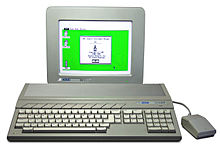
Back Atari ST ALS Atari ST AN أتاري إس تي Arabic اتارى اس تى ARZ Atari ST Catalan Atari ST Czech Atari ST Danish Atari ST German Atari ST Greek Atari ST Spanish
This article needs additional citations for verification. (April 2023) |
 | |
| Type | Personal computer |
|---|---|
| Release date | June 1985 |
| Introductory price |
|
| Discontinued | 1993 |
| Units sold | 2.1 million[1] |
| Operating system | Digital Research's GEM on Atari TOS |
| CPU | 68000 @ 8+ MHz |
| Memory | 512 KB to 4 MB |
| Graphics | 320 × 200 (16 colors) 640 × 200 (4 colors) 640 × 400 (monochrome) |
| Sound | YM2149F |
| Predecessor | Atari 8-bit family |
Atari ST is a line of personal computers from Atari Corporation and the successor to the Atari 8-bit family. The initial model, the Atari 520ST, had limited release in April–June 1985, and it was widely available in July.[2][3] The ST was the first personal computer with a bitmapped color graphical user interface,[4] using a version of Digital Research's GEM interface / operating system, from February 1985.[5][better source needed]
The Atari 1040ST, released in 1986 with 1 MB of primary or main internal memory, was the first home computer with a cost per kilobyte of RAM under US$1/kB.[6]
After Jack Tramiel purchased the assets of the Atari, Inc. consumer division to create Atari Corporation, the 520ST was designed in five months by a small team led by Shiraz Shivji.[7] Alongside the Macintosh, Amiga, Apple IIGS, and Acorn Archimedes, the ST is part of a mid-1980s generation of computers with 16- or 32-bit processors, 256 KB or more of RAM, and mouse-controlled graphical user interfaces. "ST" officially stands for "Sixteen/Thirty-two",[8] referring to the Motorola 68000's 16-bit external bus and 32-bit internals.
The ST was sold with either Atari's color monitor or less expensive monochrome monitor. Color graphics modes are available only on the former while the highest-resolution mode requires the monochrome monitor. Some models can display the color modes on a TV. In Germany and some other markets, the ST gained a foothold for CAD and desktop publishing. With built-in MIDI ports, it was popular for music sequencing and as a controller of musical instruments among amateur and professional musicians. The primary competitor of the Atari ST was the Amiga from Commodore.[9]
The 520ST and 1040ST were followed by the Mega series, the STE, and the portable STacy. In the early 1990s, Atari released three final evolutions of the ST with significant technical differences from the original models: TT030 (1990), Mega STE (1991), and Falcon (1992). Atari discontinued the entire ST computer line in 1993, shifting the company's focus to the Jaguar video game console.
- ^ Reimer, Jeremy (2005-12-15). "Total share: 30 years of personal computer market share figures". Ars Technica. Archived from the original on 2012-06-07. Retrieved 2021-11-27.
- Jeremy Reimer (2012-12-07). "Total Share: Personal Computer Market Share 1975-2010". Jeremy Reimer.
- ^ Cite error: The named reference
maremaa19850603was invoked but never defined (see the help page). - ^ "Atari Is Shipping 520 ST Computer". The New York Times. 1985-07-10.
- ^ "GUI Timeline". media.arstechnica.com. Archived from the original on 2012-10-30. Retrieved 2007-10-23.
- ^ "ANALOG TCS #1 001 03/20/85 DRI SHIPS GEM". Google Groups. Newsgroup: net.micro.atari. 1985-03-11. Retrieved 2013-04-22.
- ^ Cite error: The named reference
byte198603was invoked but never defined (see the help page). - ^ Cite error: The named reference
3yearswas invoked but never defined (see the help page). - ^ "The Future of Atari Computing". STart Magazine. December 1989. Retrieved 2006-06-23.
- ^ "Clunky". Next Generation (4). Imagine Media: 39. April 1995.
© MMXXIII Rich X Search. We shall prevail. All rights reserved. Rich X Search